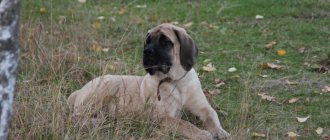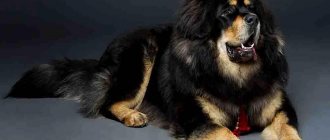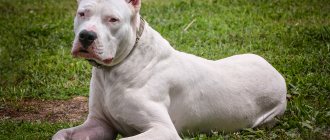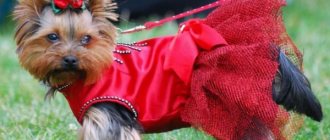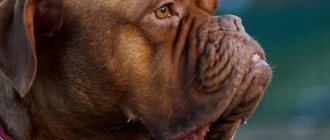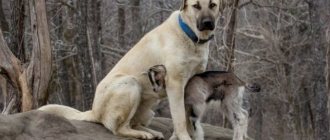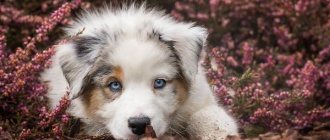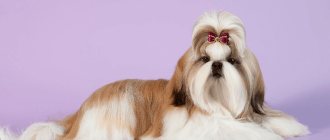The Neapolitan Mastiff is one of the largest dog breeds. This massive dog is considered an ideal guard, a loyal and devoted family friend. The breed has significant maintenance and care features that are important to consider before purchasing a puppy.
Description and features
The Neapolitan Mastiff dog was bred in Ancient Rome. She is considered one of the oldest. Previously, the dog was used as a fighter in dog competitions. He was taken to the arena, introduced to other “participants” and bets were placed on him.
The victory of such an animal in battle could bring the person who bet on it a large sum of money. The dog was respected for its courage, strength and fearlessness. But, even in the Ancient world there were people who could consider in it such virtues as affection, fidelity and tenderness.
It's hard to believe, but such a big guy can really be affectionate and kind with people. The blood of a ruthless hunter or aggressor does not flow in his body. But in order to gain the owner’s favor, the dog will certainly chase the prey. Yes, it can be used as a hunter, guard and companion.
This versatility makes a dog truly useful in everyday life. For hunting lovers, this breed is simply irreplaceable. The Neapolitan Mastiff can single-handedly defeat a small bear or jaguar. But in order to catch larger prey, he will need the help of a fellow fish.
Interesting fact! The Guinness Book of Records contains an entry for the largest domestic dog named Hercules. She is a Neapolitan Mastiff.
This dog feels comfortable in the house. He gets along well with cats, rats and other animals that dogs are often intolerant of. They are recommended to be used primarily as bodyguards and watchmen, but their affectionate attitude towards almost all living creatures suggests their friendly nature.
By itself, the dog is absolutely not angry, balanced and well controlled. But, if the process of its socialization is not controlled by a person, it can turn into an angry and suspicious beast. With proper training, mastiffs become obedient, cheerful and very gentle pets.
Their level of adaptation is amazing. Such dogs will quickly get used to any terrain, the main thing is that the owner is next to them. They become very attached to him. Mastiffs will never leave their loved ones in danger. They feel like real protectors of the family. They have a special attitude towards small children. When interacting with children, such dogs show their best qualities, namely care, affection, tenderness, and friendliness.
We can say with confidence that the Neapolitan Mastiff breed is not at all dangerous. She is friendly towards strangers if the owner is friendly with them, gets along well with other pets in the house, and adores children.
Predispositions
Since Great Danes are one of the largest dog breeds, they are susceptible to musculoskeletal ailments, both congenital and acquired with age.
The most common are elbow and hip dysplasia, anterior cruciate ligament disease, osteodystrophy, osteosarcoma, ligament and tendon sprains, and bursitis.
From the side of skin diagnoses: demodicosis, dermatitis, histiocytoma and pododermatitis.
The eyes are susceptible to cataracts and glaucoma.
This breed is also prone to cardiovascular diseases: cardiomyopathy, aortic stenosis (from birth) and heart rhythm disturbances.
Great Danes may develop entropion of the eyelids and stomach.
Breed standard
Mastiffs are large and heavy dogs. They are considered one of the most massive dogs. The height at the withers of an average-sized male is 70 cm, and that of a female is 65-68 cm. Such a dog weighs from 55 to 70 kg. If the animal's weight is more than 75 kg, this is not considered a deviation from the standard. That is, overweight Neapolitan Mastiffs are also allowed to participate in competitions and competitions for animals.
The dog stands out with its huge head. There are large folds of skin on it. Above small eyes, “eyebrows” and folds of medium thickness are clearly visible. Wrinkles on an animal’s body do not interfere with its life at all. But dust accumulates between them, which should be removed.
This animal has very powerful jaws with sharp teeth. They are covered with thick drooping cheeks. Sometimes saliva drips from the mastiff's mouth. The ears are medium length, semi-dropping. The Neapolitan Mastiff in the photo is depicted as a little aloof. In appearance, his gaze does not seem friendly at all. This is due to the specific shape of the eyes. They are tiny and deep-set.
The dog's massive neck is connected to its powerful body by a wide, muscular neck. She also has a clearly visible chest. The body has a rectangular shape. The paws are long and strong.
The tail is thickened. According to the standard, 1/3 of it is usually docked. Mastiffs are distinguished by a specific gait. She is confident, slightly sweeping. These dogs are classified as short-haired.
German dog
The Great Dane is a breed of dog belonging to the group of giant dogs. The predecessor of this animal were Molossian dogs, brought from England by the Romans during military campaigns. Ancient relatives of the Great Dane are the Asian fighting dogs.
The ancestors of the Great Dane are considered to be a combination of Bullenbeisers (Old English Danes) with large hunting dogs. The latter, in turn, descended from greyhounds and hounds.
In the second half of the 19th century, purposeful breeding of dogs began to develop in Germany, as a result of which they were given the name “German”.
Character
Yes, such animals don’t look cute at all. They appear overly suspicious, distant and distrustful. But this is completely inconsistent with their character. The Neapolitan Mastiff is one of the friendliest dogs.
He becomes strongly attached to every living creature that interacts with him at home. Love is shown to them in a special way. The animal sits next to the person it sympathizes with and rests next to him. The presence of a dog at your feet is a sign of her great love.
Representatives of this breed cannot be called mobile and overly active. They like a measured lifestyle, relaxing in the fresh air, under the sun. But the fun of young children can awaken a storm of emotions in them. Being near babies, mastiffs become more active. They can bring the child a toy, lie down next to him, play tag, etc.
Loyalty is their key feature. Mastiffs will never betray their owners. And they will not attack people, especially in the presence of household members. Yes, they cope well with guard tasks, but anger towards living beings in a home environment is alien to them.
The “Neapolitan” can attack only if its owner is not nearby, but one of the strangers tries to cross his territory. In this case, the dog will chase the suspicious person and attack him.
At the same time, it will not cause injury to a potential attacker. Mastiffs are able to hold a person for a long time with their powerful jaws until he gives up. It is useless to count on victory in a fight with them. This is a strong and morally stable breed.
When children's laughter is not heard in the house, and suspicious people do not walk behind the fence, a well-fed and happy healthy dog will sleep. He prefers to go outside and lie down to rest directly under the sun's rays.
Laziness is one of the main traits of his character. The dog will rise to its feet only as a last resort. By the way, she sleeps very soundly. But the presence of watchdog instincts encourages the mastiff to never let down his guard. Their peace can be disturbed by the singing of birds, the sound of a car, the call of a person, etc.
With people they don't trust, mastiffs are often headstrong and stubborn. To interact with them, it is important to adhere to clear role positions. Representatives of this breed are quite selective in social contacts. They need a strong and experienced dog owner who will teach them how to behave in the home.
The “Neapolitans” have one more feature - sloppiness. They may get dirty and not even notice it. Also, a large dog often destroys things without noticing it.
For example, a mastiff can swing its long tail and break a vase. The sloppiness of such animals is noticeable at the time of the meal. They like to throw food past the bowl and then collect it on the floor. This causes difficulties.
This dog will be healthy in all respects only if an emotional and psychological connection is established between it and its owners. She needs affection and care. It is important for a Mastiff to be loved and understood. He will definitely reciprocate his attentive owners.
Poll: What is your Neapolitan Mastiff like?
Obedience
He listens to me, there is no problem with that.
16.67%
Doesn't always follow commands, especially if he doesn't consider them particularly interesting.
50%
An independent and willful dog, he has serious problems with obedience.
33.33%
Voted: 6
Temperament
Calm disposition, one might even say phlegmatic. We prefer the sofa to be active.
0%
Active outside, at home he collapses on the sofa/bed and falls asleep.
40%
Probably, when calmness was distributed, my dog stood in line for activity along with the Aussie.
60%
Voted: 5
Friendliness
He loves only me, he accepts others with calm in his eyes.
20%
Loves the whole family, we spend a lot of time together. Wary of strangers.
80%
This loving giant is ready to hug anyone and everyone.
0%
Voted: 5
Protective and security qualities
He protects both me and his territory.
42.11%
It may begin to bark when strangers approach, but this is where the protection ends.
36.84%
Safety and security is not about us.
21.05%
Voted: 19
Maintenance and care
Keeping a large, massive dog in a small room is very difficult. Despite laziness and lack of excessive activity, such animals need ample space. They love to be outside, bask in the sun, listen to different sounds, sniff the ground for tracks, etc.
Therefore, we advise only those people who live in the house to get mastiffs. The dog needs to build an enclosure. It is advisable that there be a large booth in which she can rest comfortably. We recommend insulating it with cotton wool. An alternative is to cover the floor with hay.
Regarding care. Impurities accumulate between the dog's skin folds. They need to be removed regularly. Otherwise, severe inflammation will occur. A regular damp cloth will help clean your dog's fur from dust and dirt.
Use only disposable hygiene products! Purchase a brush in advance to care for the mastiff's coat. You should comb his body with it 2-3 times a week. When the dog sheds, the number of treatments can be increased.
Dirt accumulates not only between the dog’s skin folds, but also near its eyes. It can be removed with water or a damp cotton pad. You will have to bathe such a pet infrequently, no more than once a year. You should use high-quality shampoo that contains beneficial extracts.
Neapolitan Mastiffs have one feature - drooling. It can cause inconvenience to household members, especially if they live in an apartment. To help your dog get rid of excess saliva, it is recommended to remove it with a napkin or gloved hand.
Is it possible to keep in an apartment?
Since the Mastino Neapolitan is a very large dog, the space for keeping it should be spacious. In small apartments the pet will be cramped. In addition, during games it can cause damage to furniture. You will also have to come to terms with the profuse salivation that occurs periodically in this breed.
Arrangement of a resting place
Mastiff (dog): what types of breed are there?
The room where the pet lives should be large. It is undesirable for it to be damp and too stuffy. For a healthy rest, purchase a soft mat or lounger.
Note! The surface of the lying area should not be hard. Otherwise, calluses and corns will form on the dog’s body. If the dog lives in the yard, then a spacious enclosure with soft bedding is needed.
Walking and physical activity
Every day you need to walk your dog for about 2-3 hours. During the walk, the pet explores the surrounding area and gets to know other dogs. During this period, the owner can play with the dog or teach commands. Long-term walking ensures the full development of the muscular system.
Best places to walk:
- forest;
- River bank;
- a park;
- meadows
Important! During walks, you need to make sure that the mastiff does not get heatstroke. In summer, it is preferable for the dog to be in the shade and have constant access to water.
Nutrition
take a Neapolitan Mastiff puppy home after he is at least 2 months old. Before this, he must feed on mother's milk every day. When the baby gets comfortable at home, it is important to correctly transfer him to a new diet. He should eat 5-6 times a day, at least. From 5 months of age, the puppy is transferred to 4 feedings a day. His meals:
- Cow's or goat's milk. It is advisable to boil it in advance.
- The meat is raw, or boiled. You should not choose fatty varieties, such as pork. It is better to buy chicken fillet or lean beef for your dog.
- Wheat/rice/buckwheat cereals. Butter is added to it - the main source of vegetable fats.
- Cottage cheese, hard cheese or homemade yogurt. Dairy products should not be fatty.
This feeding is provided until the dog is 1 year old. Next, it is better to switch her to dry food. Add food to your mastiff's bowl daily to get him used to his new diet. You can also additionally feed your pet with boiled chicken eggs, vegetables, berries and fruits. The main thing is not to overfeed him! Overweight dogs do not cope with the guard task to the fullest extent.
Interesting Facts
Jewelers in Alexandria considered the stomach of an English mastiff to be the best way to cut precious stones. The cable organs had the advantage. The stone was placed in a piece of meat with bones, since their fragments perfectly polished the jewel inside the animal. The dog’s stomach coped with the work so expertly that the craftsmen had almost nothing left to do. Among other things, the stone acquired a special shine.
In Rome, dogs were excellent fishermen for gobies. The mastiff stirred the water and then waited for the fish to calm down. Then the pet lowered its head into the liquid and exhaled. When the bulls began to swim out, the mastiff jumped into the water and hit the water with its paws. The mud rising from the bottom got into the gills of the poor bulls, who had already been stunned by strong blows from above.
Reproduction and lifespan
Nowadays, not only professionals, but also beginners engage in breeding dogs. The basic requirement for candidates for mating is that each of them must have an exterior that fully complies with the breed standard.
The first heat of a Neapolitan Mastiff female occurs between 6 and 10 months of age. But, at this time, mating her with a male is contraindicated. They must reach 2 years of age before conceiving. Young, physically weak dogs will never give birth to healthy puppies.
A successful conception is indicated by the female’s rounded belly. Usually, it becomes like this within a month after breeding. If this does not happen, it is recommended to repeat the meeting of the dogs. The optimal period for mating large breed dogs is the 3-4th day of the bitch's heat. Neapolitan Mastiffs live from 9 to 12 years.
Varieties of colors
The breed standard allows the following types of colors.
Preferred:
- grey;
- lead gray;
- black;
- brown;
- pale yellow;
- dark fawn (red fawn).
Small white patches on the chest and/or toes are acceptable. All of these colors can be brindle.
Acceptable colors:
- walnut;
- gray-blue;
- Isabella shades.
Price
Those who want to become the owner of an elite dog should not rush to choose one. We recommend visiting a few dog shows and talking to breeders before making a purchase. After you have received some valuable advice from the professionals, you can head to one of the nurseries.
This is the best place to buy a dog. The nursery regularly monitors the health, nutrition and behavior of each puppy. The price of a Neapolitan mastiff in such an institution is from 40 to 90 thousand rubles. The cost of an animal is influenced by several factors: its age, health, the presence of parents with a title, as well as color and exterior features.
You can also make a similar purchase from private breeders. This will save you several tens of thousands of rubles, but keep in mind that the breeder cannot guarantee you the excellent health of the puppy.
Choosing a puppy
You should choose a puppy in a special nursery that breeds this breed. Here the buyer can see the baby's parents, as well as younger brothers. It is worth examining the puppy before purchasing. The paws should be strong and strong. It is important that the muzzle is short and wide. The puppy's skin is also in folds, the main part of which is on the face and neck. The coat is uniform and short throughout the body.
The cost of a mastiff in Russia is from 25 thousand rubles*
The Neapolitan Mastiff is one of the best guard dog breeds. She has excellent hearing, vision, speed and agility. Such a dog will become a good friend for all family members.
*Prices are as of November 2022.
Education and training
This is a peaceful dog breed, but this does not mean that it does not need socialization. Such animals should be placed in a social environment from an early age. She must learn to interact with people of different ages, as well as with animals. Any negative emotions that she experiences when in contact with various living beings should be condemned.
Important! Remember, the Neapolitan Mastiff should not show aggression towards anyone while at home. But if this happens, the owner should raise his voice at him.
Never reward a pet's bad behavior with petting or kind words. Thus, it learns to perceive this or that action inadequately. Owners, often without suspecting it, instill anger and distrust of others in their dog's puppy.
For example, when stroking a pet on the head when it growls at someone. Do not forget that the mastiff is a watchman and bodyguard, but this does not give him the right to attack everyone who crosses his territory, man or beast.
A dog, not without protective potential, will guard the territory only in the absence of its owner. If he is nearby, the beast will completely shift responsibility to him. For a purebred Neapolitan Mastiff, this behavior is normal.
The animal's excellent memory allows it to easily remember commands of different levels of complexity. Greater efficiency in training can be achieved if he has one teacher, preferably the owner.
Some breeders who release adult large dogs do not have the opportunity to raise them themselves. Therefore, they turn to dog handlers for help. In the case of a mastiff, this is advisable. The dog will listen to a serious-minded person who will lead it.
The voice is the best tool in raising such a dog. Raising or lowering your voice can significantly affect your dog's behavior. She always listens to the intonation of the person speaking to her and adapts to it.
Advice! The Neapolitan Mastiff is a large pet. If he is spoiled, he risks becoming a big problem for the household. We recommend that from childhood we teach him to obey and respond adequately to what is happening. Otherwise, he can sweep dishes off the table, break vases standing on window sills, etc.
It is important that a large dog living with people knows:
- Your nickname.
- Where is his sleeping place?
- What bowl can you eat from?
- When not to disturb the owners.
- Which one is his master?
- Basic commands.
Saint Bernard
Another one of the largest dogs in the world is sometimes considered the St. Bernard. There are two varieties: short-haired and long-haired.
The Saint Bernard comes from the breed described above - the Mastiff of Tibet, which was crossed with the local dogs of Europe.
The name itself comes from the French Chien du Saind-Bernard, which means “Saint Bernard’s dog.”
In the 11th century, a monk named Bernard founded a shelter for lovers of travel. Then not only the pass in the Alps is named after him, but also the shelter itself. Since the building was located in the mountains at an altitude of about 2400 km, natural disasters occurred frequently. To save victims in the 17th century, they decided to use St. Bernards. The thick skin of the dogs not only protected them from snow and ice, but also warmed the survivors. In addition, the animal had an incredible sense of smell, which was able to find victims even under avalanches.
Possible diseases and methods of treating them
Mastiffs are tough dogs, but they have a number of genetic diseases. Let's list the main ones:
- Limb injuries. In winter, these large dogs often break their paws, especially if they walk on ice. In this case, they only require veterinary care. Before hospitalization, the owner can only splint the pet.
- Helminthic intestinal lesions. Every domestic dog should be given medications against ticks and worms at least once a year. An animal's body affected by parasites becomes weak.
- Allergic reaction. Mastiffs may be allergic to flowering plants, insects, or specific foods. It is important to immediately determine the source of the adverse reaction in their body in order to eliminate it forever.
- Heart pathologies.
In order for the dog to live as long as possible, the owner should include natural foods in its diet, give it monthly vitamins, and regularly take it to the veterinarian for preventive examinations.
About health
The lifespan of giant dogs is often shorter than that of smaller representatives of human friends. Thus, mastiffs live on average from 8 to 10 years, but some individuals live up to 14 and even 17 years.
Like all living beings, dogs are also prone to certain types of diseases. Mastiffs most often experience the following health problems:
- dysplasia of the joints and retina, as well as glaucoma, cataracts;
- the skin may be affected by demodicosis, pyoderma, allergic reactions;
- from the nervous system - muscle dystrophy, epilepsy and myasthenia;
- oncology: leukemia, osteosarcoma;
- cardiovascular: cardiomyopathy, pulmonary stenosis, heart murmur;
- reproductive system: hyperplasia, cryptorchidism;
- others: hernia, spinal spondylosis, arthritis, cysts.
